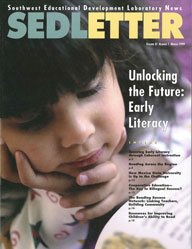Editor's Note: Reading Instruction, A Key to the Future
"It supports phonics and whole language," said some readers of the report. "This ends the 'reading wars'," declared others.
But what if there were no war? No territories drawn between phonics and whole language? Instead, what if there were a "map" of the multiple factors that research tells us determine reading ability? And what if teachers were able to use that map to select tests that would help identify students' strengths and weaknesses in reading? And once they had collected that information, what if they could choose instructional materials, strategies, and settings to sharpen the child's reading strengths and address the weaknesses? Wouldn't a teacher, then, be able to use the most appropriate method based on the child's needs rather than on the method of his or her teacher training program?
These are questions SEDL researchers asked a little more than a year ago. And in the year since the NRC report was released, they have been working with teachers in Arkansas, Louisiana, New Mexico, Oklahoma, and Texas to arrive at some of the answers. Tested with partners at schools in the region, SEDL's approach combines application of reading research with development of tools and delivery of teacher professional development to help teachers understand the research so they can make instructional decisions based on that understanding.
The lead story, "Ensuring Early Literacy through Coherent Instruction" describes SEDL's Reading Coherence Initiative which provides teachers with a conceptual framework based on cognitive research. Using the framework, elementary teachers will be better able to identify and assess essential reading-related strengths and weaknesses in their students.
During the past year, states in SEDL's Southwestern Region have also taken advantage of the momentum created by the NRC report to develop or refine statewide early literacy initiatives. We highlight states' efforts to create and disseminate research-based resources, provide educator professional development, and create policies and resources targeting children who have difficulties learning to read in "Reading Across the Region."
Two SEDL states—New Mexico and Texas—have large populations of Hispanic students. Teaching students who have limited English proficiency to read in English is an area in which many teachers have not received training. In "Cooperative Education—the Key to Bilingual Success?" Las Cruces freelance writer Pamela Porter interviews Dr. Margarita Calder—n about the Bilingual Cooperative Integrated Reading and Composition program, components of which have proved very successful in the popular Success For All reading program. Porter also provides a summary of the work and success of the New Mexico State University America Reads Challenge Site in "New Mexico State University Is Up to the Challenge."
Jill Slack, coordinator of the Reading Success Network for the Southeast Comprehensive Assistance Center, discusses how the RSN process helps prepare teachers to instruct struggling readers in "The Reading Success Network: Linking Teachers, Building Community."
Finally, as in every SEDLetter, we include research- based information you can use to explore the complex issues related to early literacy and delivery of reading instruction. "Resources for Early Literacy" was compiled by SEDL's Office of Institutional Communications and Policy Services and includes ordering information from the organizations cited there.
Next Article: Ensuring Early Literacy through Coherent Instruction

